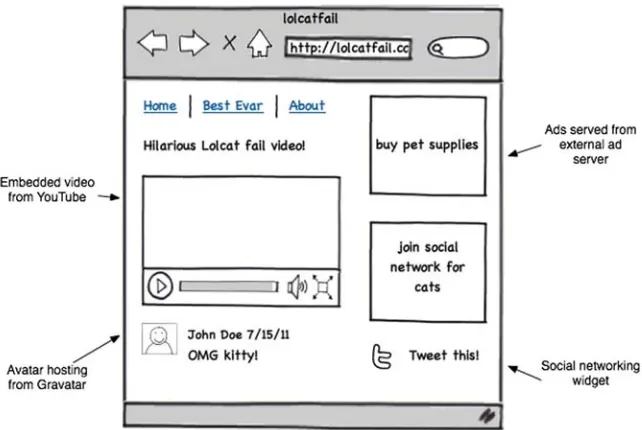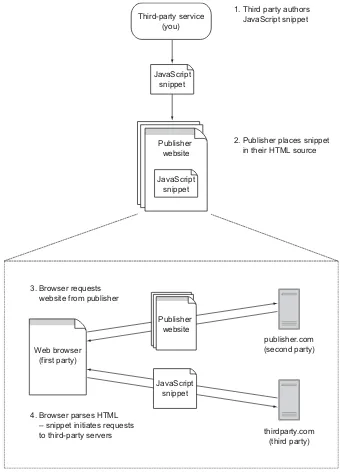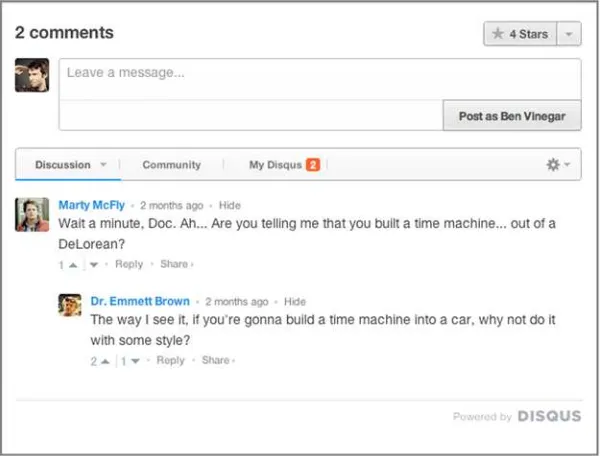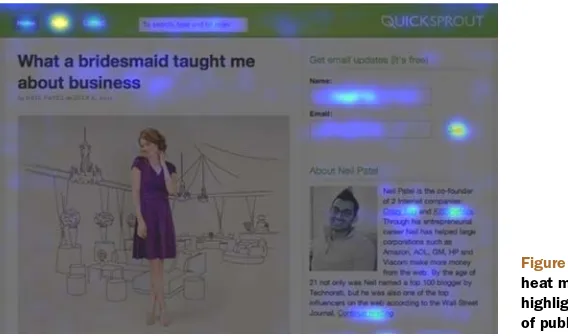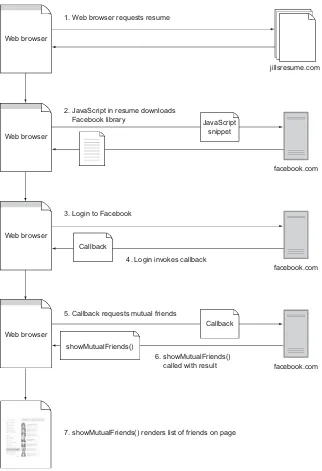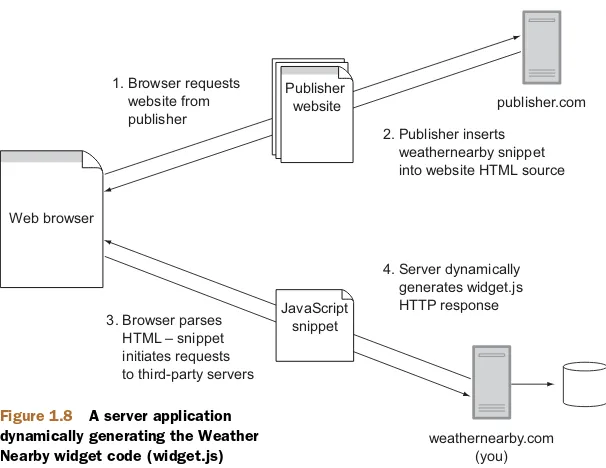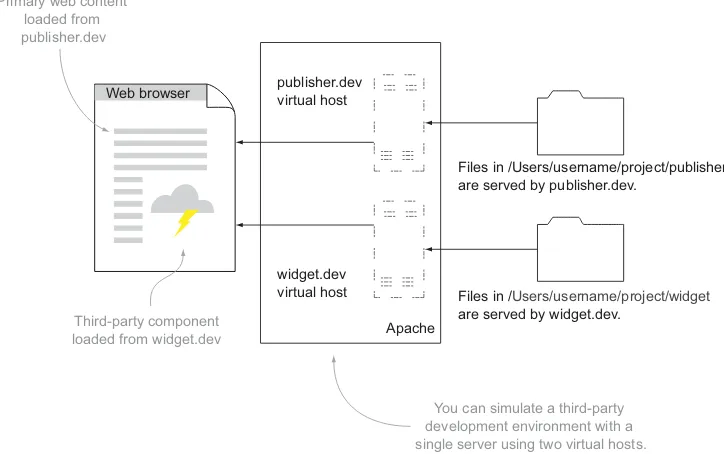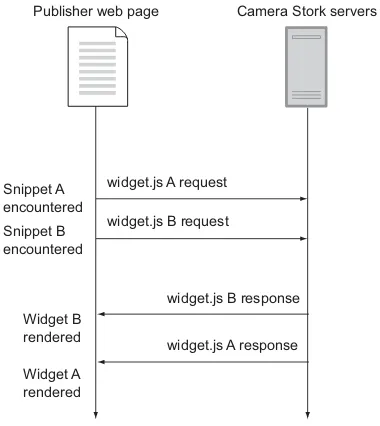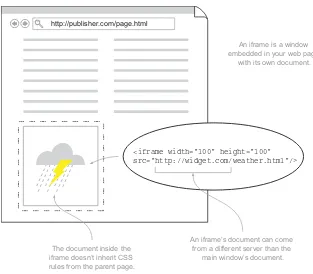Third-Party JavaScript
BEN VINEGAR
ANTON KOVALYOV
For online information and ordering of this and other Manning books, please visit
www.manning.com. The publisher offers discounts on this book when ordered in quantity. For more information, please contact
Special Sales Department Manning Publications Co. 20 Baldwin Road
PO Box 261
Shelter Island, NY 11964 Email: orders@manning.com
©2013 by Manning Publications Co. All rights reserved.
No part of this publication may be reproduced, stored in a retrieval system, or transmitted, in any form or by means electronic, mechanical, photocopying, or otherwise, without prior written permission of the publisher.
Many of the designations used by manufacturers and sellers to distinguish their products are claimed as trademarks. Where those designations appear in the book, and Manning
Publications was aware of a trademark claim, the designations have been printed in initial caps or all caps.
Recognizing the importance of preserving what has been written, it is Manning’s policy to have the books we publish printed on acid-free paper, and we exert our best efforts to that end. Recognizing also our responsibility to conserve the resources of our planet, Manning books are printed on paper that is at least 15 percent recycled and processed without the use of elemental chlorine.
Manning Publications Co. Development editor: Renae Gregoire
20 Baldwin Road Technical proofreaders: Alex Sexton, John J. Ryan III
PO Box 261 Copyeditor: Benjamin Berg
Shelter Island, NY 11964 Proofreader: Katie Tennant Typesetter: Dottie Marsico Cover designer: Marija Tudor
ISBN 9781617290541
Printed in the United States of America
v
brief contents
1 ■
Introduction to third-party JavaScript 1
2 ■Distributing and loading your application 21
3 ■
Rendering HTML and CSS 48
4 ■
Communicating with the server 77
5 ■
Cross-domain iframe messaging 105
6 ■Authentication and sessions 131
7 ■
Security 152
8 ■
Developing a third-party JavaScript SDK 172
9 ■
Performance 202
vii
contents
foreword xii preface xv
acknowledgments xvii about this book xix about the authors xxii
about the cover illustration xxiii
1
Introduction to third-party JavaScript
1
1.1
Defining third-party JavaScript 2
1.2
The many uses of third-party JavaScript 4
Embedded widgets 6 ■ Analytics and metrics 8
Web service API wrappers 10
1.3
Developing a bare-bones widget 13
Server-side JavaScript generation 14 ■ Distributing widgets as
iframes 16
1.4
Challenges of third-party development 17
Unknown context 17 ■ Shared environment 18
Browser restrictions 19
CONTENTS viii
2
Distributing and loading your application
21
2.1
Configuring your environment for third-party
development 22
Publisher test page 23 ■ The web server 23 ■ Simulating
multiple domains 24
2.2
Loading the initial script 26
Blocking script includes 26 ■ Nonblocking scripts with async and
defer 27 ■ Dynamic script insertion 29
2.3
The initial script file 31
Aliasing window and undefined 31 ■ Basic application flow 32
2.4
Loading additional files 33
JavaScript files 34 ■ Libraries 36
2.5
Passing script arguments 38
Using the query string 38 ■ Using the fragment identifier 41
Using custom data attributes 42 ■ Using global variables 43
2.6
Fetching application data 45
2.7
Summary 47
3
Rendering HTML and CSS
48
3.1
Outputting HTML 49
Using document.write 49 ■ Appending to a known location 50
Appending multiple widgets 52 ■ Decoupling render targets 54
3.2
Styling your HTML 55
Using inline styles 55 ■ Loading CSS files 56 ■ Embedding
CSS in JavaScript 58
3.3
Defensive HTML and CSS 61
Namespaces 61 ■ CSS specificity 62 ■ Overspecifying CSS 64
3.4
Embedding content in iframes 66
Src-less iframes 68 ■ External iframes 70 ■ Inheriting
styles 71 ■ When to refrain from using iframes? 75
3.5
Summary 76
4
Communicating with the server
77
4.1
AJAX and the browser same-origin policy 78
Rules for determining same origin 80 ■ Same-origin policy and
CONTENTS ix
4.2
JSON with padding (JSONP) 82
Loading JSON via script elements 82 ■ Dynamic callback
functions 84 ■ Limitations and security concerns 86
4.3
Subdomain proxies 88
Changing a document’s origin using document.domain 89 Cross-origin messaging using subdomain proxies 91 Combining subdomain proxies with JSONP 94 ■ Internet
Explorer and subdomain proxies 97 ■ Security implications 98
4.4
Cross-origin resource sharing 99
Sending simple HTTP requests 99 ■ Transferring cookies
with CORS 102 ■ Sending preflight requests 102
Browser support 103
4.5
Summary 104
5
Cross-domain iframe messaging
105
5.1
HTML5 window.postMessage API 106
Sending messages using window.postMessage 107 Receiving messages sent to a window 109 ■ Browser
support 110
5.2
Fallback techniques 112
Sending messages using window.name 112 ■ Sending
messages using the URL fragment identifier 115 ■ Sending
messages using Flash 118
5.3
Simple cross-domain messaging with easyXDM 120
Loading and initializing easyXDM 121 ■ Sending simple
messages using easyXDM.Socket 123 ■ Defining JSON-RPC
interfaces using easyXDM.Rpc 125
5.4
Summary 129
6
Authentication and sessions
131
6.1
Third-party cookies 132
Setting and reading sessions 133 ■ Disabling third-party
cookies 134 ■ Internet Explorer and P3P headers 136
Detecting when cookies are unavailable 138
6.2
Setting third-party cookies 140
Using dedicated windows 141 ■ Iframe workaround
(Safari only) 144 ■ Single-page sessions for Chrome
CONTENTS x
6.3
Securing sessions 147
HTTPS and secure cookies 148 ■ Multilevel authentication 149
6.4
Summary 151
7
Security
152
7.1
Cookies, sessions, and session theft 153
7.2
Cross-site scripting 154
XSS attacks 155 ■ XSS vulnerabilities in CSS 157
Defending your application against XSS attacks 159
7.3
Cross-site request forgery 161
XSRF attacks 161 ■ JSON hijacking 163 ■ Defending
your application against XSRF attacks 164
7.4
Publisher vulnerabilities 166
Publisher impersonation 166 ■ Clickjacking 168
Denial of service 170
7.5
Summary 171
8
Developing a third-party JavaScript SDK
172
8.1
Implementing a bare-bones SDK 175
Initialization 175 ■ Asynchronous loading 176
Exposing public functions 179 ■ Event listeners 180
8.2
Versioning 182
URL versioning 183 ■ Versioned initialization 185
8.3
Wrapping web service APIs 188
Accessing web service APIs on the client 188 ■ Wrapping the
Camera Stork API 191 ■ Identifying publishers 195
User authorization and OAuth 200
8.4
Summary 201
9
Performance
202
9.1
Optimizing payload 203
Combining and minifying source code 204 ■ Reducing image
requests 205 ■ Caching files 207 ■ Deferring HTTP
CONTENTS xi
9.2
Optimizing JavaScript 213
Inside the browser: UI thread, repaint, and
reflow 214 ■ Controlling expensive calls: throttle and
debounce 215 ■ Deferring computation with setTimeout 218
9.3
Perceived performance 220
Optimistic user actions 220 ■ Rendering before document
ready 222
9.4
Summary 223
10
Debugging and testing
224
10.1
Debugging 225
Serving development code in production 227 ■ Stepping through
the code 233
10.2
Testing 237
Unit, integration, and regression tests 238 ■ Writing regression
tests using QUnit 240 ■ Writing regression tests using Hiro 243
10.3
Summary 246
xiii
foreword
You, as a third-party JavaScript developer, have a multitude of concerns you need to manage to ship code across a number of sites and platform combinations. Never before have the details and best practices of making solid distributable JavaScript been codified in such depth as they are in this book. This can be a tricky business, so allow me to illustrate the potential for unintended consequences by telling you a story about Douglas Crockford, who created one of the most widely distributed third-party scripts, and a site called OnlineBootyCall.
JSON (JavaScript Object Notation) is a subset of JavaScript that was codified by Douglas. Back in 2005, he wrote json.js, a small library that could parse JSON
into JavaScript objects and stringify back in the other direction. It enjoyed significant adoption immediately, but it added the Object.prototype.toJSONString and
String.prototype.parseJSON methods which threw many folks for a loop.
In October 2007, Douglas put out json2.js. It’s not uncommon for developers to hotlink existing JavaScript versions, and Douglas’s own copy got its fair share. Soon, his hosting company emailed him asking about the unusually high traffic from a site called OnlineBootyCall.com. Douglas had included in the json2.js code a message that warned: “Use your own copy. It is extremely unwise to load code from servers you do not control.” He added a browser-locking, synchronous, and JavaScript-freezing modal alert(). The result? A pop-up on every page load of OnlineBootyCall. Ouch.
FOREWORD xiv
This book, written by two of the most expert developers on the subject, takes inventory of all the current techniques and unveils them one by one to help you write battle-hardened script for the first deployment. I hope this book will serve you well, and that you’ll be as excited about the next generation of the web as I am.
PAUL IRISH
DEVELOPER RELATIONS: GOOGLE CHROME, JQUERY
xv
preface
In February of 2010, I was on the phone with Jason Yan, CTO and cofounder of a web startup called Disqus. At the time, Disqus was a tiny company behind a fast-growing commenting application, distributed as a third-party script and popular with bloggers and a handful of large media companies. Jason was interviewing me for a JavaScript engineering role—their first hire dedicated to working on a fast-growing client codebase.
After a handful of standard JavaScript interview questions involving classes, proto-types, and scopes, Jason took a different tack. He asked me the following (roughly paraphrased) question: “Let’s say I’ve taken a native function prototype—like
Array.prototype.indexOf and assigned it a new value. How would you get the origi-nal value back?”
I was dumbstruck. This was a problem I had never encountered before, and I didn’t know the answer. Jason explained to me that the Disqus application executes in environments they don’t control. And in those environments, native properties are sometimes overwritten or mangled, properties that they depend on.
I wasn’t about to give up on the question. So in the middle of the interview, I opened up my browser’s JavaScript console, and started fiddling around with function prototypes. In a few short minutes, I made the startling discovery that you could use JavaScript’s delete operator on a modified native property, and the browser would restore the original value.
PREFACE xvi
began talking, discussing Disqus’ current solution to this problem, and the interview changed from a serious interrogation into an excited conversation about iframes, browser hacks, and other scripting gotchas.
I didn’t know it at the time, but this was my first taste of Third-party JavaScript; of solving problems that only affect client applications running in other people’s web environments; of discovering techniques and practices that some web developers may never be aware of. And I was hooked.
Several more interviews and two months later, I joined the Disqus team, which only had seven employees at the time, in San Francisco. That was where I met Anton Koval-yov, my new coworker, fellow JavaScripter, and future coauthor. For the next two-plus years, Anton and I were responsible for maintaining and developing Disqus’ client-side code. Disqus continued to grow—rapidly. By 2012, it was installed on hundreds of thousands of web pages, and received over 5 billion page views per month. Its custo-mers included CNN, MLB, IGN, Time.com, Rolling Stone, and dozens of other major web and media properties.
During that period of time, Anton and I learned dozens of helpful tricks, tips, and hacks for third-party scripters, most of which we learned the hard way, and some of which we kept under wraps intentionally, because they gave us a technological edge.
In this book, we’ve pooled our collective knowledge about third-party JavaScript. Not only do we think our book will help third-party scripters everywhere, we also think that the practices we discuss may help make the web a better place for everybody. We hope that by the end of reading it, you’ll agree.
xvii
acknowledgments
We found writing this book a daunting and challenging experience, and we recognize that there’s no way we could have done it on our own. We want to take a moment and acknowledge the folks who have contributed to this work, both directly and indirectly. First of all, we’d like to thank Daniel Ha, Jason Yan, and the team at Disqus, not only for employing us, but for building and maintaining the amazing platform from which most of the material in this book derives.
Secondly, we’d like to thank the fine folks at Manning for taking a chance on what many felt was a niche topic. Without them, this book wouldn’t exist. We especially want to thank our editor Renae Gregoire, for helping us through the writing process and holding our hands from beginning to end. We’d also like to thank the editing and production team at Manning for their help tweaking our text and improving the many figures and diagrams that dot this work.
We’d especially like to thank our technical reviewer, Alex Sexton, for lending his experience on this topic and for sharing his own treasure trove of third-party JavaScript tricks; John Ryan III for his review of the final manuscript during produc-tion, shortly before we went to press; and Paul Irish for contributing the foreword and for agreeing to lend his name to a couple of unworthy amateurs.
ACKNOWLEDGMENTS xviii
Brian Dillard, Brian Forester, David Vedder, Jake McCrary, Jeffrey Yustman, Jonas Bandi, Justin Pope, Margriet Bruggeman, Nikander Bruggeman, and Sopan Shewale.
Finally, thanks to everyone who commented on the manning.com forums, shouted at us on Twitter, or commented to us about the book in person—every little bit helped and we’re grateful.
BEN VINEGAR
I would like to dedicate this book to my parents, David and Wendy. Beginning with the Commodore 64 you bought me as a child, you’ve always fostered my interest in computing and I’d have never gotten here without you. Special thanks also to my partner, Esther, for her encouragement and patience during what has been a chal-lenging project.
ANTON KOVALYOV
I would like to dedicate this book (even the parts that Ben wrote) to my parents, who were very supportive when I decided to spend most of my time staring at my com-puter screen, waiting for Gentoo to compile. And thanks to Pamela Fox for inspiring me to actually work on this book instead of hacking on my side projects or watching
xix
about this book
Third-party JavaScript is independent client code executing on a publisher’s website, but served from a remote web address. It’s used in the creation of highly distributed web applications, from social widgets to analytics trackers to full-featured embedded applications.
This book serves as an introduction to third-party JavaScript application develop-ment. It teaches readers not only how to write JavaScript code that executes in third-party contexts, but also third-third-party web development techniques that involve HTML,
CSS, and even HTTP. It is intended for developers who already have experience with these technologies in a first-party context (such as your own website) and who want to explore how these technologies can be executed in a foreign web environment (some-body else’s website).
This book does not include a primer on JavaScript programming language. Nor does it teach readers the fundamentals of HTML and CSS. The book does, how-ever, include introductory material on dynamic script loading, cookies, HTTPS, and other intermediate and advanced web development topics as they are encountered in the text.
Roadmap
The book consists of ten chapters, as follows:
ABOUT THIS BOOK xx
with a quick sample third-party application, and highlights some of the difficulties of third-party web development.
Chapter 2 instructs readers on how to actually load and execute their code on a content provider’s website. It starts by describing how to set up a local development environment to simulate a third-party development. It then moves into script loading best practices, and how to extract configuration variables from a content provider’s website.
Chapter 3 focuses on DOM rendering. It teaches readers best practices for render-ing on the content provider’s DOM, an environment they don’t control. It also covers strategies for avoiding conflicting styles using CSS and iframe elements.
Chapter 4 goes over communication between your third-party script and your data servers. It begins with a discussion of the Same Origin Policy, and how it makes domain communication difficult. It then looks at two workarounds for making cross-domain requests: JSONP and subdomain proxies. It finishes with a discussion of CORS
(Cross Origin Resource Sharing), a new HTML5 browser feature that enables cross-domain requests in modern browsers.
Chapter 5 continues with cross-window messaging—including iframes. It intro-duces window.postMessage, an HTML5 browser feature that provides a simple messag-ing mechanism between windows. It then introduces a series of fallback techniques for older browsers where window.postMessage is unavailable. It also features a tutorial of easyXDM, an open-source JavaScript library that provides postMessage-like features for both modern and old browsers.
Chapter 6 is about authentication and cookies. It informs readers on the behav-iour of cookies in third-party scripts, and provides techniques for working with brows-ers when third-party cookies are disabled. It also briefly covbrows-ers security issues when working with cookies.
Chapter 7 discusses security of third-party applications. It covers both traditional vulnerabilities for JavaScript-based applications—such as Cross-Site Scripting (XSS) and Cross-Site Request Forgery (XSRF) attacks—and also vulnerabilities specific to third-party applications.
Chapter 8 guides the reader through the development of JavaScript SDK (Software Development Kit). It takes some of the features developed in the earlier chapters, and exposes them to publishers through publicly-defined functions. It also demonstrates how to provide a client-side JavaScript wrapper for an HTTP-based web services API.
Chapter 9 is about performance. It covers techniques for reducing filesize and the number of HTTP requests made by your application. It also teaches best practices for writing JavaScript code that doesn’t block the browser or other scripts.
ABOUT THIS BOOK xxi
Code conventions and downloads
All source code in listings or in text is in a fixed-widthfontlikethis to separate it from ordinary text. Code annotations accompany many of the listings, highlighting important concepts. In some cases, numbered bullets link to explanations that follow the listing.
The companion source code for this book is distributed under the MIT License. It is freely available from the publisher’s website at www.manning.com/Third-PartyJavaScript. You can also view the source code on GitHub at http://github.com/ thirdpartyjs.
Author Online
The purchase of Third-Party JavaScript includes free access to a private web forum run by Manning Publications, where you can make comments about the book, ask tech-nical questions, and receive help from the authors and from other users. To access the forum and subscribe to it, point your web browser to www.manning.com/Third-PartyJavaScript. This page provides information on how to get on the forum once you are registered, what kind of help is available, and the rules of conduct on the forum.
xxii
about the authors
BEN VINEGAR is a software engineer at Disqus, a third-party com-ments platform served on over 1,000,000 blogs, online publica-tions, and other web properties, including CNN, MLB, Time Magazine, and IGN. Before joining Disqus, Ben was a Development Team Lead and go-to JavaScript developer at FreshBooks, a leading web-based invoicing service.
xxiii
about the cover illustration
The figure on the cover of Third-Party JavaScript is captioned “Un Commandant,” which means commanding officer. The illustration is taken from a 19th-century edi-tion of Sylvain Maréchal’s four-volume compendium of regional dress customs and militray uniforms published in France. Each illustration is finely drawn and colored by hand. The rich variety of Maréchal’s collection reminds us vividly of how culturally apart the world’s towns and regions were just 200 years ago. Isolated from each other, people spoke different dialects and languages. In the streets or in the countryside, it was easy to identify where they lived and what their trade or station in life was just by their dress.
Dress codes have changed since then and the diversity by region, so rich at the time, has faded away. It is now hard to tell apart the inhabitants of different conti-nents, let alone different towns or regions. Perhaps we have traded cultural diversity for a more varied personal life—certainly for a more varied and fast-paced technolog-ical life.
1
Introduction to
third-party JavaScript
Third-party JavaScript is a pattern of JavaScript programming that enables the cre-ation of highly distributable web appliccre-ations. Unlike regular web appliccre-ations, which are accessed at a single web address (http://yourapp.com), these applica-tions can be arbitrarily loaded on any web page using simple JavaScript includes.
You’ve probably encountered third-party JavaScript before. For example, con-sider ad scripts, which generate and display targeted ads on publisher websites. Ad scripts might not be a hit with users, but they help web publishers earn revenue and stay in business. They’re visible on millions of websites, and yet nearly all of them are third-party scripts, served from separate ad servers.
This chapter covers
Explaining third-party JavaScript
Real-world examples of third-party applications
Walk-through implementation of a simple embedded widget
2 CHAPTER 1 Introduction to third-party JavaScript
Ad scripts are just one use case; developers look to third-party scripts to solve a number of problems. Some use them to create standalone products that serve the needs of publishers. For example, Disqus, a web startup from San Francisco—and the employer of the fine authors of this book—develops a third-party commenting appli-cation that gives web publishers an instant commenting system. Others develop third-party scripts to extend their traditional web applications to reach audiences on other websites. For example, Facebook and Twitter have developed dozens of social widgets that are loaded on publisher websites. These widgets help social networks engage their users outside of their applications’ normal ecosystems.
Small companies can benefit from third-party JavaScript too. Let’s say you’re the owner of a B2B (business-to-business) web application that hosts web forms to collect information from your customers’ clients. You have potential customers out there who’d love to use your application, but are hesitant to redirect their users to an exter-nal website. With third-party JavaScript, you can have customers load your form appli-cation directly on their own web pages, solving their redirect concerns.
Third-party JavaScript isn’t all gravy. Writing these applications is far from trivial. There are plenty of pitfalls and hackery you’ll need to overcome before you can ship third-party JavaScript that will hold its own in the wild. Luckily, this book will show you how by guiding you through the complete development of a full-featured third-party application.
But before we dive into the bowels of third-party JavaScript, you need to learn the fundamentals. In this chapter, we’ll better define third-party JavaScript, look at real-world implementations from a number of companies, go over a simple implementa-tion of a party applicaimplementa-tion, and discuss the numerous challenges facing third-party development.
Let’s start with trying to get a better handle on what third-party JavaScript is and what we can do with it.
1.1
Defining third-party JavaScript
In a typical software exchange, there are two parties. There’s the consumer, or first party, who is operating the software. The second party is the provider or author of that software.
On the web, you might think of the first party as a user who’s operating a web browser. When they visit a web page, the browser makes a request from a content pro-vider. That provider, the second party, transmits the web page’s HTML, images, stylesheets, and scripts from their servers back to the user’s web browser.
3
Defining third-party JavaScript
When you try to apply this definition to JavaScript, things become muddy. Many devel-opers have differing opinions on what exactly constitutes third-party JavaScript. Some classify it as any JavaScript code that providers don’t author themselves. This would include popular libraries like jQuery and Backbone.js. It would also include any code you copied and pasted from a programming solutions website like Stack Overflow. Any and all code you didn’t write would come under this definition.
Others refer to third-party JavaScript as code that’s being served from third-party servers, not under the control of the content provider. The argument is that code hosted by content providers is under their control: content providers choose when and where the code is served, they have the power to modify it, and they’re ultimately responsible for its behavior. This differs from code served from separate third-party servers, the contents of which can’t be modified by the provider, and can even change without notice. The following listing shows an example content provider HTML page that loads both local and externally hosted JavaScript files.
<!DOCTYPE html> <html>
<head>
<title>Example Content Provider Website</title>
<script src="js/jquery.js"></script> <script src="js/app.js"></script> </head>
<body>
Listing 1.1 Sample content provider web page loads both local and external scripts
Figure 1.1 Websites today make use of a large number of third-party services.
4 CHAPTER 1 Introduction to third-party JavaScript
...
<script src="http://thirdparty.com/app.js"></script> </body>
</html>
There’s no right or wrong answer; you can make an argument for both interpreta-tions. But for the purposes of this book, we’re particularly interested in the latter defi-nition. When we refer to third-party JavaScript, we mean code that is
Not authored by the content provider
Served from external servers that aren’t controlled by the content provider
Written with the intention that it’s to be executed as part of a content provider’s website
WHERE’S TYPE="TEXT/JAVASCRIPT"? You might have noticed that the <script> tag declarations in this example don’t specify the type attribute. For an “untyped” <script> tag, the default browser behavior is to treat the contents as JavaScript, even in older browsers. In order to keep the examples in this book as concise as possible, we’ve dropped the type attribute from most of them.
So far we’ve been looking at third-party scripts from the context of a content provider. Let’s change perspectives. As developers of third-party JavaScript, we author scripts that we intend to execute on a content provider’s website. In order to get our code onto the provider’s website, we give them HTML code snippets to insert into their pages that load JavaScript files from our servers (see figure 1.2). We aren’t affiliated with the website provider; we’re merely loading scripts on their pages to provide them with helpful libraries or useful self-contained applications.
If you’re scratching your head, don’t worry. The easiest way to understand what third-party scripts are is to see how they’re used in practice. In the next section, we’ll go over some real-world examples of third-party scripts in the wild. If you don’t know what they are by the time we’re finished, then our status as third-rate technical authors will be cemented. Onward!
1.2
The many uses of third-party JavaScript
We’ve established that third-party JavaScript is code that’s being executed on someone else’s website. This gives third-party code access to that website’s HTML elements and JavaScript context. You can then manipulate that page in a number of ways, which might include creating new elements on the DOM (Document Object Model), insert-ing custom stylesheets, and registerinsert-ing browser events for capturinsert-ing user actions. For the most part, third-party scripts can perform any operation you might use JavaScript for on your own website or application, but instead, on someone else’s.
5
The many uses of third-party JavaScript
Web browser (first party)
publisher.com (second party)
thirdparty.com (third party) 2. Publisher places snippet
in their HTML source
3. Browser requests website from publisher
4. Browser parses HTML – snippet initiates requests to third-party servers
1. Third party authors Third-party service JavaScript snippet
(you)
JavaScript snippet
JavaScript snippet Publisher
website
JavaScript snippet
Publisher website
6 CHAPTER 1 Introduction to third-party JavaScript
Armed with the power of remote web page manipulation, the question remains: what is it good for? In this section, we’ll look at some real-world use cases of third-party scripts:
Embedded widgets—Small interactive applications embedded on the publisher’s web page
Analytics and metrics—For gathering intelligence about visitors and how they interact with the publisher’s website
Web service API wrappers—For developing client-side applications that communi-cate with external web services
This isn’t a complete list, but should give you a solid idea of what third-party JavaScript is capable of. We’ll start with an in-depth look at the first item: embedded widgets.
1.2.1 Embedded widgets
Embedded widgets (often third-party widgets) are perhaps the most common use case of third-party scripts. These are typically small, interactive applications that are ren-dered and made accessible on a publisher’s website, but load and submit resources to and from a separate set of servers. Widgets can vary widely in complexity; they can be as simple as a graphic that displays the weather in your geographic location, or as complex as a full-featured instant messaging client.
Widgets enable website publishers to embed applications into their web pages with little effort. They’re typically easy to install; more often than not publishers need only insert a small HTML snippet into their web page source code to get started. Since they’re entirely JavaScript-based, widgets don’t require the publisher to install and maintain any software that executes on their servers, which means less maintenance and upkeep.
Some businesses are built entirely on the development and distribution of embed-ded widgets. Earlier we mentioned Disqus, a web startup based in San Francisco. Dis-qus develops a commenting widget (see figure 1.3) that serves as a drop-in commenting section for blogs, online publications, and other websites. Their product is driven almost entirely by third-party JavaScript. It uses JavaScript to fetch comment-ing data from the server, render the comments as HTML on the page, and capture form data from other commenters—in other words, everything. It’s installed on web-sites using a simple HTML snippet that totals five lines of code.
Disqus is an example of a product that’s only usable in its distributed form; you’ll need to visit a publisher’s page to use it. But widgets aren’t always standalone products like this. Often they’re “portable” extensions of larger, more traditional stay-at-home web applications.
7
The many uses of third-party JavaScript
Incredibly, all of this magic also comes in a widget flavor. Publishers can embed the maps application on their own web pages using some simple JavaScript code snippets obtained from the Google Maps website. On top of this, Google provides a set of pub-lic functions for publishers to modify the map contents.
Let’s see how simple it is to embed an interactive map on your web page using Google Maps (listing 1.2). This code example begins by first pointing to the Maps JavaScript library using a simple script include. Then, when the body’s onload handler fires, you check whether the current browser is compatible, and if so, initialize a new map and center it at the given coordinates.1 We’re done, and all it took was roughly 10
lines of code—powerful stuff!
<!DOCTYPE html> <html>
<head>
<title>Google Maps Example</title> <script src="
https://maps.googleapis.com/maps/api/js?v=3.exp&sensor=false"> </script>
<script> var map;
1 Not everyone knows latitude and longitude by heart. Luckily, Google has additional functions for converting street addresses to geographical coordinates. Learn more at http://code.google.com/apis/maps.
Listing 1.2 Initializing the Google Maps widget
8 CHAPTER 1 Introduction to third-party JavaScript
function initialize() { var mapOptions = {
zoom: 8,
center: new google.maps.LatLng(43.6481, -79.4042), mapTypeId: google.maps.MapTypeId.ROADMAP
};
map = new google.maps.Map(document.getElementById('map_canvas'), mapOptions);
} </script> </head>
<body onload="initialize()">
<div id="map_canvas" style="width: 500px; height: 300px"></div> </body>
</html>
We just looked at two examples of embedded widgets. But really, any application idea is fair game for embedding on a publisher’s page. In our own travels, we’ve come across a wide variety of widgets: content management widgets, widgets that play real-time video, widgets that let you chat in real real-time with a customer support person, and so on. If you can dream it, you can embed it.
1.2.2 Analytics and metrics
Third-party JavaScript isn’t used exclusively in the creation of embedded widgets. There are other uses that don’t necessarily involve graphical, interactive web page ele-ments. Often they’re silent scripts that process information on the publisher’s page without the user ever knowing they’re there. The most common such use case is in analytics and metrics gathering.
One of JavaScript’s most powerful features is that it enables developers to capture and respond to user events as they occur on a web page. For example, you can write JavaScript to respond to a website visitor’s mouse movements and/or mouse clicks. Third-party scripts are no exception: they too can observe browser events and capture data about how the visitor interacts with the publisher’s page. This might include tracking how long a visitor stays on a page before moving on, what content they saw while they were reading the page, and where they went afterward. There are dozens of browser events your JavaScript code can hook into from which you could derive hun-dreds of different insights.
PASSIVESCRIPTS
9
The many uses of third-party JavaScript
Crazy Egg’s third-party script is considered a passive script; it records statistical data without any interaction from the publisher. The publisher is solely responsible for including the script on the page. The rest happens automatically.
ACTIVESCRIPTS
Not all analytics scripts behave passively. Mixpanel is an analytics company whose product tracks publisher-defined user actions to generate statistics about website visi-tors or application users. Instead of generic web statistics, like page views or visivisi-tors, Mixpanel has publishers define key application events they want to track. Some exam-ple events might be “user clicked the signup button,” or “user played a video.” Pub-lishers write simple JavaScript code (see listing 1.3) to identify when the action takes place and then call a tracking method provided by Mixpanel’s third-party scripts to register the event with their service. Mixpanel then assembles this data into interest-ing funnel statistics to help answer questions like, “What series of steps do users take before upgrading the product?”
<button id="signup">Sign up!</button>
<script src="http://api.mixpanel.com/site_media/js/api/mixpanel.js"> </script>
<script>
var mpmetrics = new MixpanelLib(PUBLISHER_API_TOKEN);
jQuery(function() {
jQuery('#signup').click(function() {
mpmetrics.track("signup button clicked"); });
}); </script>
Unlike Crazy Egg, Mixpanel’s service requires some development work by the pub-lisher to define and trigger events. The upside is that the pubpub-lisher can collect custom data surrounding user actions and answer questions about user activity.
Listing 1.3 Tracking user signups with the Mixpanel JS API
Figure 1.4 Crazy Egg’s heat map visualization highlights trafficked areas of publishers’ websites.
Initialize Mixpanel library
Attach click event handler to signup button using jQuery
10 CHAPTER 1 Introduction to third-party JavaScript
There’s something else interesting about Mixpanel’s use of third-party scripting. In actuality, Mixpanel provides a set of client-side functions that communicate with their web service API—a set of server HTTP endpoints that both track and report on events. This is a practical use case that can be extended to any number of different services. Let’s learn more.
1.2.3 Web service API wrappers
In case you’re not familiar with them, web service APIs are HTTP server endpoints that enable programmatic access to a web service. Unlike server applications that return
HTML to be consumed by a web browser, these endpoints accept and respond with structured data—usually in JSON or XML formats—to be consumed by a computer program. This program could be a desktop application or an application running on a web server, or it could even be client JavaScript code hosted on a web page but exe-cuting in a user’s browser.
This last use case—JavaScript code running in the browser—is what we’re most interested in. Web service API providers can give developers building on their plat-form—often called integrators—third-party scripts that simplify client-side access to their API. We like to call these scripts web service API wrappers, since they’re effectively JavaScript libraries that “wrap” the functionality of a web service API.
EXAMPLE: THE FACEBOOK GRAPH API
How is this useful? Let’s look at an example. Suppose there’s an independent web developer named Jill who’s tired of freelance work and looking to score a full-time job. Jill’s decided that in order to better appeal to potential employers, she needs a terrific-looking online resume hosted on her personal website. This resume is for the most part static—it lists her skills and her prior work experience, and even mentions her fondness for moonlight kayaking.
Jill’s decided that, in order to demonstrate her web development prowess, there ought to be a dynamic element to her resume as well. And she’s got the perfect idea. What if visitors to Jill’s online resume—potential employers—could see if they had any friends or acquaintances in common with Jill (see figure 1.5)? Not only would this be a clever demonstration of
Jill’s skills, but having a common friend could be a great way of getting her foot in the door.
To implement her dynamic resume, Jill uses Facebook’s Graph API. This is a web service API from Facebook that enables soft-ware applications to access or modify live Facebook user data (with permission,
11
The many uses of third-party JavaScript
of course). Facebook also has a JavaScript library that provides functions for communi-cating with the API. Using this library, it’s possible for Jill to write client-side code that can find and display friends common to herself and a visitor to her resume. Figure 1.6 illustrates the sequence of events that occur between the browser and the two servers.
Web browser
jillsresume.com 1. Web browser requests resume
Web browser
2. JavaScript in resume downloads Facebook library
facebook.com
Web browser
Web browser
3. Login to Facebook
4. Login invokes callback
facebook.com Callback
JavaScript snippet
5. Callback requests mutual friends
6. showMutualFriends()
called with result facebook.com showMutualFriends()
Callback
7. showMutualFriends() renders list of friends on page
12 CHAPTER 1 Introduction to third-party JavaScript
Listing 1.4 shows the code to implement this feature on her resume. To keep things simple, this example uses jQuery, a JavaScript library, to simplify DOM operations. Learn more at http://jquery.com.
<!DOCTYPE html> <html>
<!-- rest of resume HTML above -->
<a href="#" id="show-connections">Show mutual friends</a>
FB.init({ appId: 'FACEBOOK_APP_ID' });
$('#show-connections').click(function() {
url = '/' + userID + '/mutualfriends/jill?fields=name,picture'; FB.api(url, showMutualFriends);
var friends = response.data; friends.forEach(function (friend) {
out += '<li>';
out += '<img src="' + friend.picture + '"/>'; out += friend.name + '</li>';
Jill managed to embed some powerful functionality in her resume, all using a small amount of client-side JavaScript. With this impressive piece of work, she should have no problem landing a top-flight software job.
BENEFITSOFCLIENT-SIDE API ACCESS
It’s worth pointing out that this entire example could’ve been done without client-side JavaScript. Instead, Jill could’ve written a server application to query the Facebook Graph API for the necessary data and then render the result as HTML in the response
Listing 1.4 Using Facebook’s Graph API to fetch and display a list of mutual friends
Load both jQuery and Facebook JavaScript SDK.
13
Developing a bare-bones widget
to the browser. In that case, the browser downloads the HTML from Jill’s server and displays the result to the user—no JavaScript is executed.
But it’s arguably better to have the website visitor perform this work in the browser, for a few reasons:
Code executing in the browser is code that’s not executing on the integrator’s servers, which can lead to bandwidth and CPU savings.
It’s faster—the server implementation has to wait for the response from Face-book’s API before showing any content.
Some websites are completely static, such that client-side JavaScript is their only means of accessing a web service API.
AN API FOR EVERY SEASON This example we just covered might be regarded as a niche use case, but this is just one possible application. Facebook is just a single web service API provider, but the reality is that there are thousands of popular APIs, all of which provide access to varying data and/or functionality. Besides social networking applications like Facebook, Twitter, and LinkedIn, there are publishing platforms like Blogger and WordPress, or search applica-tions like Google and Bing, all of which provide varying degrees of access to their data via APIs.
Many web services—large and small—offer APIs. But not all of them have gone the extra mile of providing a JavaScript library for client-side access. This matters because JavaScript in the browser is the single largest development platform: it’s supported on every website, in every browser. If you or your organization develops or maintains a web service API, and you want to reach the largest number of possible integrators pos-sible, you owe it to yourself to provide developers with a client-side API wrapper—a topic we’ll discuss in detail later in this book.
1.3
Developing a bare-bones widget
We’ve explored some popular uses for third-party JavaScript. You’ve seen how it can be used in the development of widgets, in analytics gathering, and as a client-side wrapper for web service APIs. Hopefully this has given you an idea of what’s possible when you’re designing your own third-party application.
Now that you’ve walked through some real-world exam-ples, it’s time to develop something yourself. Let’s start with something fairly simple: a bare-bones embedded widget.
Pretend for a moment that you run a website that provides up-to-the-minute local weather information. Traditionally, users visit your website directly in order to get the latest weather news. But in order to reach a wider audience, you’ve decided to go a step further and give users access to your data outside of your website. You’ll do this by providing an embed-dable widget version of your service, depicted in figure 1.7.
14 CHAPTER 1 Introduction to third-party JavaScript
You’ll market this widget to publishers who are interested in providing their readers with local weather information, with the easy installation of a third-party script.
Luckily, you’ve already found a publisher who’s interested, and they’ve signed on to test-drive your widget. To get them started, you’ll need to provide them with an
HTML snippet that will load the weather widget on their web page. The publisher will copy and paste this snippet into their HTML source code at the location where they want the widget to appear. The snippet itself is simple: it’s a <script> tag pointed to a third-party JavaScript file hosted on your servers at weathernearby.com:
<script src="http://weathernearby.com/widget.js?zip=94105"> </script>
You’ll notice the URL for this script element contains a single parameter, zip. This is how you’ll identify what location to render weather information for.
Now when the browser loads the publisher’s web page, it’ll encounter this
<script> tag and request widget.js from your servers at weathernearby.com. When widget.js is downloaded and executed, it’ll render the weather widget directly into the publisher’s page. That’s the goal, at least.
To do this, widget.js will need to have access to the company’s weather data. This data could be published directly into the script file, but given that there are approxi-mately 43,000 US ZIP codes, that’s too much data to serve in a single request. Unless the user is connecting from Sweden or South Korea, where 100 Mbps connections are the norm, it’s clear that the widget will need to make separate requests for the weather data. This is typically done using AJAX, but for simplicity we’ll use a different approach: server-side script generation.
1.3.1 Server-side JavaScript generation
Instead of serving a static JavaScript file that contains your widget code, you’ll write a server application that generates a JavaScript file for every request (see figure 1.8). Because your server has access to your weather database, it can inject the requested weather data into the outputted JavaScript file. This means that the JavaScript file will contain all the code and data necessary to render the weather widget on the pub-lisher’s page, without having to make any additional requests.
15
Developing a bare-bones widget
WHY PYTHON? The small handful of server-side examples in this book is writ-ten in Python. Our reason for choosing this programming language is com-pletely biased: it’s what we use every day at Disqus, and we’re most familiar with it. If you don’t know how to write Python, that’s okay. This is first and foremost a book about JavaScript and the server-side examples could easily be rewritten in any language.
' <p><strong>%s °F</strong> — %s</p>' + '</div>'
);
''' % (data['location'], data['image'], data['temp'], data['desc'])
Listing 1.5 Server implementation of widget.js, written in Python and Flask—server.py Web browser
Figure 1.8 A server application dynamically generating the Weather Nearby widget code (widget.js)
A full-fledged Flask application. It starts by importing a few helper libraries, including Flask, and a utility function for querying the weather database. Initialize
Flask application.
Define a single route: '/widget.js'. When server starts, Flask will listen to all requests for /widget.js and respond by executing this function.
16 CHAPTER 1 Introduction to third-party JavaScript
response = make_response(out) response.headers['Content-Type'] = \
'application/javascript'
return response
After this server endpoint is up and running, a <script> request to http:// weathernearby.com/widget.js?zip=94105 should return the following JavaScript code. This renders the sample widget you saw at the beginning of this section (see figure 1.7). Also, note that the fact that this code is served from a Python application is completely transparent to the requesting browser.
document.write( '<div>' +
' <p>San Francisco, CA</p>' +
' <img src="http://weathernearby.com/img/partly-cloudy.png"/>' + ' <p><strong>87 °F</strong> — Partly Cloudy</p>' + '</div>'
);
Now, when we said this would be a bare-bones example earlier, we weren’t kidding. This outputs a completely unstyled weather widget that offers absolutely no interac-tion with the user. It looks awful, and has probably put your fledgling weather com-pany in jeopardy. But it works, and it illustrates the interaction between publisher websites and third-party code.
Some of the techniques illustrated here, like using document.write and server-side Python, aren’t the only ways to generate widgets. And for reasons we’ll explain later, they’re even frowned upon. In future chapters, we’ll explore alternate, better solu-tions, and tackle more complicated features like stylesheets, server communication via
AJAX, and user sessions.
1.3.2 Distributing widgets as iframes
If you’re fairly experienced with web development, you might be thinking to yourself, “Isn’t it easier to distribute this widget as an iframe?” At first blush it might seem so, but there are not-so-obvious differences that make third-party scripts the better imple-mentation choice. In order to understand why, let’s first see how you can re-create the preceding example widget using iframes.
In case you’re not familiar with them, iframes are block-level HTML elements designed to embed external content served from a URL. You could easily re-create the weather widget example using strictly an iframe element, like so:
<iframe style="border:none;height:200;width:150"
src="http://weathernearby.com/widget.html?zip=94105"/>
You’ll notice the target src attribute has changed: it’s no longer pointing to a JavaScript file, but instead to an HTML document. This time your server endpoint will return a fully formed HTML document containing the widget markup, completely avoiding the need for JavaScript. You’ll also notice the dimensions of the widget are
17
Challenges of third-party development
provided as part of the iframe’s style attribute. Iframe elements don’t expand to fit their contents, and need to be given explicit dimensions.
Using an iframe like this should produce the same output as the JavaScript exam-ple. So why use JavaScript over iframes, even for a simple example like this? There are many reasons, most of which revolve around a particular attribute of iframes: that external content loaded inside an iframe can’t be accessed by the parent page (the pub-lisher’s page), and vice versa.
Flexibility—If you ever want to change the dimensions of the widget, you’ll be out of luck. Since the iframe dimensions are fixed on the iframe element on the parent page, and those attributes can’t be modified from content loaded inside the iframe, there’s no way to dynamically resize the widget.
Aesthetics—The look and feel of the widget will need to be completely indepen-dent of the parent page’s styles. The widget won’t be able to inherit basic styles, like font family, size, or color.
Interaction—Will the widget need to read or modify the publisher’s DOM? What if the publisher needs to interact with the contents of the widget? Could multi-ple instances of the widget communicate with each other? None of these are possible with static iframes.
Reporting—Did the browser user actually view the widget? How much time did they spend on the page before viewing it? Retrieving this and other valuable sta-tistics requires JavaScript running on the publisher’s page.
These are just a few examples, but you’re probably beginning to see a trend. Iframes may be the simplest mechanism for distributing the weather widget example, but in doing so you’ll lose many compelling abilities offered by third-party JavaScript. But don’t let this sour your opinion of iframes. They’re an invaluable asset in the third-party JavaScript developer’s toolset, and we’ll use them frequently for a number of dif-ferent tasks over the course of this book.
1.4
Challenges of third-party development
You’ve learned how third-party JavaScript is a powerful way to write highly distribut-able applications. But writing scripts that run on other people’s websites carries a unique set of challenges distinct from regular JavaScript programming. Specifically, your code is being executed in a DOM environment that you don’t control, on a differ-ent domain. This means you have to contend with a number of unexpected complexi-ties, like an unknown web page context, a JavaScript environment shared with other first- and third-party scripts, and even restrictions put in place by the browser. We’ll take a quick look at what each of these entails.
1.4.1 Unknown context
18 CHAPTER 1 Introduction to third-party JavaScript
pages that sport a variety of different doctypes, DOM layouts, and CSS rules, and ought to work correctly in all of them.
You have to consider that a publisher might include your script at the top of their page, in the <head> tag, or they might include it at the bottom of the <body>. Publish-ers might load your application inside an iframe, or on a page where the <head> tag is entirely absent; in HTML5, head sections are optional, and not all browsers automati-cally generate one internally. If your script makes assumptions about these core ele-ments when querying or appending to the DOM, it could wind up in trouble.
If you’re developing an embedded widget, displaying proper styles also becomes a concern. Is the widget being placed on a web page with a light background or a dark background? Do you want your widget to inherit styles and “blend” into the pub-lisher’s web design, or do you want your widget to look identical in every context? What happens if the publisher’s HTML is malformed, causing the page to render in quirks mode? Solving these problems requires more than well-written CSS. We’ll cover solutions to these issues in later chapters.
1.4.2 Shared environment
For a given web environment, there’s only one global variable namespace, shared by every piece of code executing on the page. Not only must you take care not to pollute that namespace with your own global variables, you have to recognize that other scripts, possibly other third-party applications like yours, have the capability of modify-ing standard objects and prototypes that you might depend on.
For example, consider the global JSON object. In modern browsers, this is a native browser object that can parse and stringify JSON (JavaScript Object Notation) blaz-ingly fast. Unfortunately, it can be trivially modified by anyone. If your application depends on this object functioning correctly, and it’s altered in an incompatible way by another piece of code, your application might produce incorrect results or just plain crash.
The following sample code illustrates how easy it is to modify the global JSON
object by using simple variable assignment:
JSON.stringify = function() {
/* custom stringify implementation */ };
You might think to yourself, “Why would anyone do such a thing?” Web developers often load their own JSON methods to support older browsers that don’t provide native methods. The bad news is that some of these libraries are incompatible in sub-tle ways. For example, older versions of the popular Prototype JavaScript library pro-vide JSON methods that produce different output than native methods when handling undefined values:
// Prototype.js
19
Challenges of third-party development
// Native
JSON.stringify([1, 2, undefined]) => "[1, 2, null]"
The JSON object is just one example of a native browser object that can be altered by competing client code; there are hundreds of others. Over the course of this book we’ll look at solutions for restoring or simply avoiding these objects.
Similarly, the DOM is another global application namespace you have to worry about. There’s only one DOM tree for a given web page, and it’s shared by all applica-tions running on the page. This means taking special care when you interact with it. Any new elements you insert into the DOM have to coexist peacefully with existing ele-ments, and not interfere with other scripts that are querying the DOM. Similarly, your
DOM queries can inadvertently select elements that don’t belong to you if they’re not scoped properly. The opposite is also true; other applications might accidentally query your elements if you haven’t carefully chosen unique IDs and class names.
Since your code exists in the same execution environment as other scripts, security also becomes a taller order. Not only do you have to protect against improper use by users of your application, you also have to consider other scripts operating on the page, or even the publisher, to be a potential threat. For example, if you’re writing a widget or script that ties to a larger, popular service, like a social networking website, publishers might have a vested interest in attempting to fake user interactions with their own pages.
1.4.3 Browser restrictions
If an unknown document context, multiple global namespaces, and additional secu-rity concerns aren’t bad enough, web browsers actively prohibit certain actions that often directly affect third-party scripts. For example, AJAX has become a staple tool of web developers for fetching and submitting data without refreshing the page. But the web browser’s same-origin policy prevents XmlHttpRequest from reaching domains other than the one you’re on (see figure 1.9). If you’re writing a third-party script that needs to get or send data back to an application endpoint on your own domain, you’ll have to find other ways to do it.
In the same vein, web browsers also commonly place restrictions on the ability of applications to set or even read third-party cookies. Without them, your users won’t be able to “log in” to your application or remember actions between subsequent requests. Depending on the complexity of your application, not being able to set or read third-party cookies can be a real hindrance.
20 CHAPTER 1 Introduction to third-party JavaScript
Unfortunately, this list of challenges is just the tip of the iceberg. Third-party JavaScript development is fraught with pitfalls, because at the end of the day, the web browser wasn’t built with embedded applications and third-party code in mind. Brows-ers are getting better, and new features are being introduced that alleviate some of the burden of doing third-party development, but it’s still an uphill battle, and supporting old browsers is typically a must for any kind of distributed application.
But don’t worry. You’ve already made the fine decision of purchasing this book, which will cover the problems facing your third-party JavaScript code. And as an added bonus, we’ll even tell you how to solve them.
1.5
Summary
Third-party JavaScript is a powerful way of building embedded and highly distribut-able web applications. These applications can come in many shapes and sizes, but we looked at three specific use cases: as interactive widgets, as passive scripts that collect data, and as developer libraries that communicate with third-party web APIs. But com-pared to developing regular stay-at-home web applications, third-party scripts face additional challenges. They require you to execute your code in an unknown, shared, and potentially hostile browser environment.
21
Distributing and loading
your application
Let’s pretend you’re the owner of a small but growing e-commerce website. Your online store specializes in the sale of cameras and camera accessories, and carries the playful name of Camera Stork (http://camerastork.com).1 You’re doing well at
attracting business, and you’ve developed a loyal customer base of both profes-sional and amateur photographers. Your website has a bustling review section for each product, where many of your customers have submitted ratings and reviews of their purchases.
Some of these customers are so fanatical about your store that they’d love to refer directly to your products from their own blogs and websites. In the past, you’ve handed out referral URLs for publishers to link directly to your products, but the experience is subpar, and you’d like to go further.
This chapter covers
Configuring your development environment
Including scripts on a publisher’s web page
Loading supporting JavaScript files and libraries
Passing parameters to your third-party script
22 CHAPTER 2 Distributing and loading your application
The solution: an embeddable widget (see figure 2.1) that shows up-to-date information about a specific product, and a link to purchase it at your store. It’ll include all the standard product information: name, photo, price, and average rating. But it won’t be strictly read-only. Given that your store has a strong emphasis on user reviews, you also want users to be able to submit new reviews from the widget. Since it’s impor-tant to know who’s reviewing what, you also want users to be able to log in through the widget, and even persist sessions between different widget instances.
As you might expect, you’ll implement this widget as a third-party JavaScript application. Just like the weather widget example from chapter 1, loyal fans (or publishers) will obtain an HTML snippet from your e-commerce store and insert it
into their own web pages’ HTML source code. This snippet will load your application code and render the widget on their web page. The location in their HTML source code where the snippet is placed denotes where the widget will be rendered.
We’ll develop this product widget over the course of the book. Later chapters will deal with more advanced topics: communicating with the server, rendering, maintain-ing sessions, and performance. But before we get there, we have to address some important first steps: getting your application code loaded and executed on the pub-lisher’s website.
There’s a lot more to this than you might expect. For starters, you’ll need to craft the aforementioned HTML snippet that will load your initial script file on publishers’ web pages. Then you’ll need to load any supporting JavaScript files, libraries, and stylesheets. You’ll also need to figure out how the publisher will pass parameters to your script files, in order to identify what product they’re trying to embed on their page. And unlike the weather widget example from chapter 1, you’ll do all of this without using any server-side script generation.
But since this is your first foray into the art of third-party development, you’ll also want to spend a few minutes to configure your local development machine to represent the cross-domain environment you’ll be writing your code for. Let’s tackle that next.
2.1
Configuring your environment for
third-party development
As we discussed in chapter 1, the web browser treats scripts that communicate with external servers differently than regular script files. To tackle these issues head-on, it’s
highly recommended that you simulate a cross-domain environment on your local development machine. If you don’t, it’s extremely likely that you’ll run into unforeseen problems when you deploy your code onto live servers. We’re guessing you don’t want that to happen, so in this next section, we’ll guide you through such a configuration.
Mikon E90 Digital SLR
$599.99 – Buy now
Login and review
4.3/5.0 • 176 reviews
